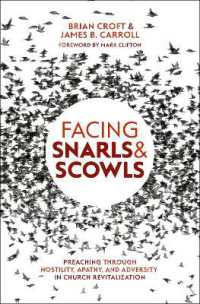- ホーム
- > 洋書
- > 英文書
- > Science / Mathematics
Full Description
Using a designed vector field to guide robots to follow a given geometric desired path has found a range of practical applications, such as underwater pipeline inspection, warehouse navigation, and highway traffic monitoring. It is thus in great need to build a rigorous theory to guide practical implementations with formal guarantees. It is even so when multiple robots are required to follow predefined desired paths or maneuver on surfaces and coordinate their motions to efficiently accomplish repetitive and laborious tasks.
The book introduces guiding vector fields on Euclidean spaces and Riemannian manifolds for single-robot and multi-robot path-following and motion coordination, provides rigorous theoretical guarantees of vector field guided motion control of robotic systems, and elaborates on the practical implementation of the proposed algorithms on mobile wheeled robots and fixed-wing aircraft. It provides guidelines for the robust, reliable, and safe practical implementations for robotic tasks, including path-following navigation, obstacle-avoidance, and multi-robot motion coordination.
In particular, the book reveals fundamental theoretic underpinnings of guiding vector fields and applies to addressing various robot motion control problems. Notably, it answers many crucial and challenging questions such as:
· How to generate a general guiding vector field on any n-dimensional Riemannian manifold for robot motion control tasks?
· Do singular points always exist in a general guiding vector field?
· How to generate a guiding vector field that is free of singular points?
· How to design control algorithms based on guiding vector fields for different robot motion control tasks including path-following, obstacle-avoidance, and multi-robot distributed motion coordination?
Answering these questions has led to the discovery of fundamental assumptions, a "topological surgery" to create a singularity-free guiding vector field, a robot navigation algorithm with the global convergence property, a provably safe collision-avoidance algorithm and an effective distributed motion control algorithm, etc
Contents
Introduction.- Preliminaries.- Part I Theoretical foundation: Vanishing level value and convergence to zero-level set.- Path following control in 3d using a vector field.- Topological analysis of vector-field guided path following on manifolds.- The domain of attraction of the desired path in vector-field guided path following.- Refined dichotomy convergence in vector-field guided path-following on Rn.- Part II Applications with formal guarantees: Guiding vector fields for following occluded paths.- A singularity-free guiding vector field for robot navigation.- Guiding vector fields for multi-robot coordinated navigation .- Conclusions and future research.- III Appendix.







